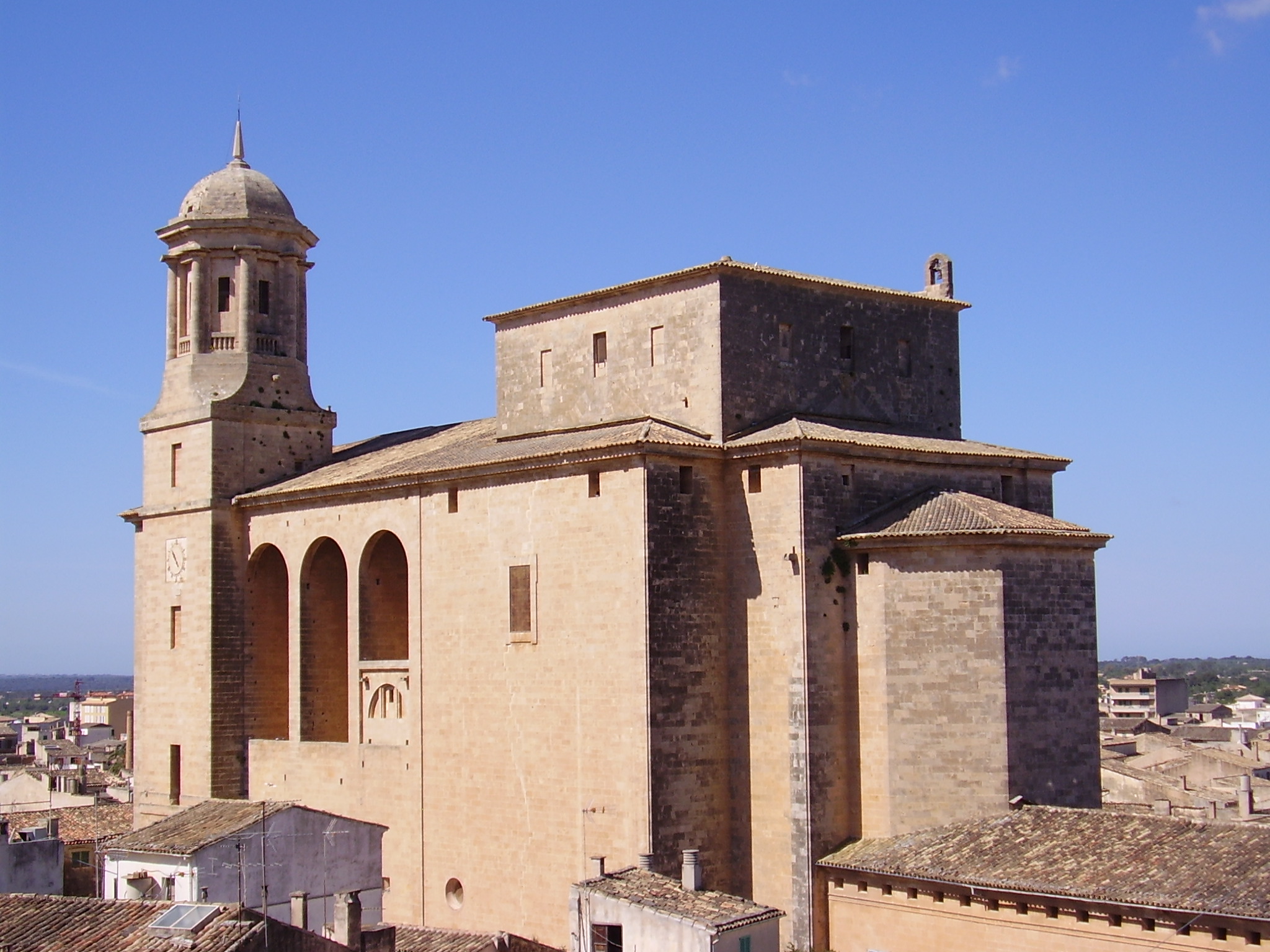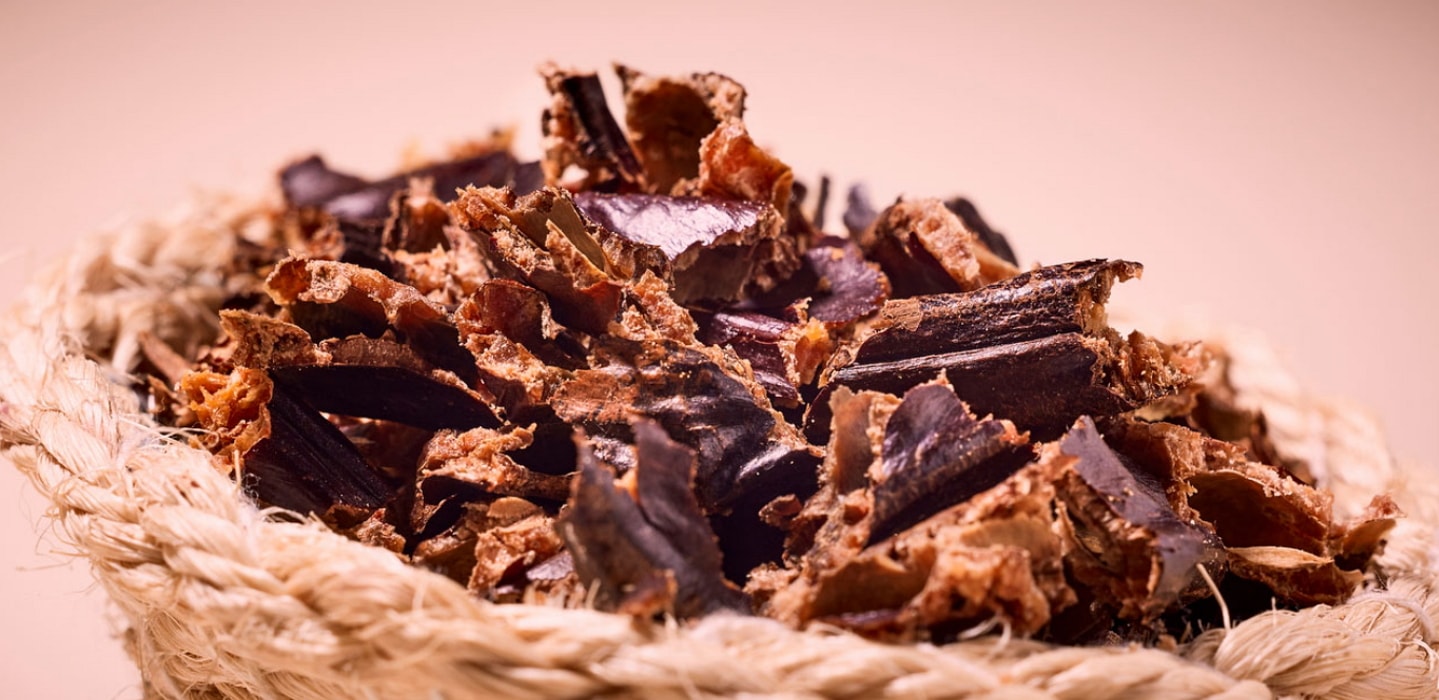The first church was built in the 14th century and was demolished by the current construction. It was a single-storey enclosure with side chapels and all that remains of this church are: a rose window, which is located on the western wall of the present church, a starting line of an arch and two capitals.
The construction of the present church began in 1784 on the initiative of the parish priest Evinent, and was completed at the end of the 19th century. Its size and grandeur were the cause of numerous hardships and difficulties in its construction.
Various projects and guidelines made up a complex that was directed by different master builders and architects, including A. Mesquida and Friar Miquel de Petra in the 18th century, and Isidro González Velázquez and the architect Joan Sureda in the 19th century.
The church conserves the Baroque deep chapel that was attached to the previous temple, although, with the new construction, this deep chapel was adapted to the Neoclassical style, eliminating the Baroque architectural elements it had.
With regard to the church, we can distinguish two construction phases. In the first, we find the presbytery, the transept area and the side doorway, which shows us that it is still rooted in the resources of the classicist Baroque style.
Of the second, we can talk about the main nave, the dome and the bell tower, marked by the neoclassical reform of the Madrid architect Isidro González Velázquez.
The main façade is of impressive sobriety, showing the rejection of the proposals that were put forward for it, as any ornamental element is eliminated and a section is advanced beyond what was foreseen.
The side façade has two entrance portals and a bell tower with five bays, following the plan of the architect from Madrid.
The ground plan of the church has a single nave, with an inscribed dome-shaped transept and side chapels. The interior elevation has three sections: the lower section has chapels, the middle section combines a blind gallery with a tribune area, and the upper section, above the cornice, has lunettes and windows between the starts of the transverse arches of the barrel vault.
The church has nineteen altarpieces, of which five are preserved in the Baroque style (of San Francisco Javier (11), Santo Domingo (12), Nuestra Señora del Rosario (13), Santo Cristo de la Esperanza (14), Santa Ana (20)).
With the construction of the new church it was necessary to make new altarpieces to decorate it. These follow neoclassical guidelines and most of them were built in the 1840s. The most influential artistic workshop during this period in Mallorca, with an important influence in Llucmajor, was the Torres workshop, which produced numerous pictorial, sculptural and ornamental pieces for the new building.
High altarpiece of San Miguel (1). This altarpiece, designed by the architect Isidro González Velázquez, imitates the architectural elements of a classical temple. Saint Michael in the centre is flanked by the holy archangels Raphael and Gabriel, between double Corinthian fluted columns. In the truncated entablature is the Holy Spirit and, above him, in the attic, the sculptures of St. Matthew and St. Thomas. All the altarpieces from this period in this church follow the same structure, with more or less variations.
Altarpiece of Santo Cristo de las Ánimas (2). Altarpiece in neoclassical style. Inside the linteled niche is the titular Baroque image. It is articulated and is used for the representation of the Descent from the Cross during Holy Week. It is a religious representation, which comes from the medieval theatre.
Altarpiece of San Sebastián (3). It has the same structure as the previous altarpiece. In this case, the central niche has a semicircular arch, where the image of Saint Sebastian is placed and below it his relic, transferred from the church of Montuïri in 1681. Saint Sebastian is the patron saint of Palma and is the protector against the plague.
Altarpiece of the Holy Trinity (4). It was moved from its original site (today the chapel of the Sacred Heart of Jesus) to its present location at the beginning of the 20th century, which led to some restructuring. The central motif of the altarpiece is pictorial and represents the coronation of Mary by the Holy Trinity.
Altarpiece of the Name of Jesus (5). The disappearance of the central niche, typical of the other altarpieces, has given way to a pictorial motif. In the predella and inside a niche we can see an image of the Child Jesus.
Altarpiece of Our Lady of Lourdes (6). The formal lines of this altarpiece are an imitation of rococo. Some of its formal, chromatic and decorative features can be found in Llucmajor as an appendix of the Baroque period, in the decoration of the mouldings of the interior doorways of the Rectory House and those of the presbytery and, in general, of all the decorative elements of the church of the Sanctuary of Nuestra Señora de Gracia, although in some areas of this church they have disappeared due to the restoration work carried out in the early 1990s.
Altarpiece of San José (7). This is a masonry altarpiece and follows the usual classical structure, with a central niche with a carpanel arch and a 19th-century image.
Altarpiece of the Sacred Heart of Jesus (8). Built at the beginning of the 20th century, it features the image of the Heart of Jesus inside a dome-shaped baldachin and accompanied by sculptures of angels. Inside, in a semi-crypt, there is a recumbent figure of Saint Candida, patron saint of Llucmajor.
Altarpiece of Santa Lucía (9). This altarpiece, like that of the Immaculate Heart of Mary, is embedded in the wall within a semicircular arch on pilasters.
The niche contains the image of Saint Lucy, martyred in the 4th century.
Altarpiece of the Immaculate Heart of Mary (10). This altarpiece, like the previous one, is located in the space that connects the main nave with the Baroque deep chapel of the previous church. The very simple work was completed in 1843.
Altarpiece of San Francisco Javier (11). Baroque style altarpiece in which we can appreciate the abandonment of the baroque style found in other altarpieces of the same artistic style, as it presents more classical lines and a reduction in the number of ornamental motifs.
Altarpiece of Santo Domingo (12). Baroque style altarpiece. It is from the 18th century and has a Dominican iconography (Saint Thomas Aquinas and Saint Vincent Ferrer on the sides). The lack of stucco reveals the features of the carved wood of the altarpiece. In the centre of the predella there is a niche with the image of Saint John the Baptist, inserted in the 19th century following the neoclassical trend.
Altarpiece of Our Lady of the Rosary (13). This is a Baroque altarpiece from 1651, probably made shortly after the construction of the chapel, which dates from the same period. The entire altarpiece has a profusion of decorative architectural elements typical of the period. It was restored in 2001, restoring its original appearance by opening the attic niche, which had been hidden by a painting in the 19th century.
Altarpiece of the Santo Cristo de la Esperanza (14). Baroque style altarpiece. The image of the Santo Cristo de la Esperanza (Holy Christ of Hope), dating from the late 16th century, belongs to the devotion of the Blood, which was established in Palma from 1552 onwards, from where it spread to other towns on the island. These Christs share the same formal features. In the attic we see the 16th century painting of the Virgin of Hope within a Renaissance composition, both in terms of the lines of perspective marked by the tiling and the classical frame of the background.
Altarpiece of Santa Catalina Thomás (15). This chapel, which formerly housed the relics of Saint Candida, was restructured at the beginning of the 20th century and changed its owner. Unlike the others, this one is represented by an altarpiece on the wall. The central painting of Santa Catalina stands out and underneath there is a niche with a carving of Nuestra Señora de la Lactancia (Our Lady of Lactation). In recent years, the chapel has been dedicated to the Mallorcan saints by incorporating the paintings of Ramón Llull, Sister Francinaina Cirer and Sister Maria dels Àngels Ginard Martí.
Altarpiece of Our Lady of Piety (16). This was one of the last altarpieces in this church to be built. It shows an influence derived from the classicist Baroque altarpieces of the 18th century. The Pietà was restored at the beginning of the 20th century to adapt it to the new space. Furthermore, both iconographically and stylistically, it suggests its Baroque origin.
Baptismal font (17). Cup-shaped font enclosed by a wooden pyramid and crowned by an iron cross. It is enclosed by an iron gate.
Next to the baptismal font, there is a spiral staircase that gives access, first, to the choir and after climbing 119 steps we reach the bell tower. There we find three bells: the largest (1788), the medium-sized (1647) and the smallest and oldest (1643).
Altarpiece of San Isidro (18). Apart from the lateral ceramic panels of the same origin as those in the chapel of San Antonio, the two superimposed central niches stand out. The lower Baroque image represents the chapel’s patron saint, while the upper one is a Gothic carving of the Virgin, popularly known as La Candelaria.
Altarpiece of Saint Anthony (19). It is one of the few chapels with ceramic decoration on the wall, a ceramic of Valencian origin from the second half of the 19th century. The patronage of this chapel is due to the devotion to the Saint and his brotherhood, of great importance in the town of Llucmajor until the end of the 19th century. Inside the church we can find the interventions of the brotherhood in the tau cross of the central rose window and in the execution of the ecclesiastical canopy.
Altarpiece of Santa Ana (20). This 18th century Baroque altarpiece is dedicated to the mother of Mary, with a whole series of iconographies that refer to the saint. It seems to have been the subject of a later readaptation. In an inventory it is described as having a central niche with an image of the Virgin, which would explain the current lack of unity in the area of the predella in the central street.
MUSIC IN THE CHURCH (21)
Art is not only material but also immaterial, like poetry, literature or music. Any church has an important part dedicated to music: choir books, prayers, chanting of the Sibyl, musical instruments… The previous church already had a choir, built in 1594, and the present one continued with the custom of placing it in the uppermost section of the nave. However, among the musical instruments in a church, the organ is undoubtedly the most important instrument. In Llucmajor, the origin of organ music dates back to 1414, the year in which the construction of an organ by the organ builder Pere Granyera is recorded, a type of music that has been heard in the Llucmajor church from then until the present day. In 1549, the old organ was rebuilt and enlarged by the organ builder Gaspar Roig.
The new factory also affected the old instrument, since at the end of the 19th century a balcony was built where it was temporarily placed. In 1912 the current balcony was finally built. The historic organ in the parish church comes from the one built by the Swiss organ builder Ludwig Scherrer in 1804 for the church of Santa Eulalia in Palma, which, dismantled at the beginning of the 20th century, was reassembled in its current location together with the parts of the old parish organ.
The façade was designed by the local clergyman Miquel Salvà. It is an organ made up of typological parts of the classical Mallorcan school and parts of European origin. The instrument is Baroque in character, with three keyboards. It was restored in 1984 by the German Gerhard Grenzing.
THE MUSEUM OF THE PARISH CHURCH OF SAN MIGUEL
The museum was created in 2004 to conserve and exhibit the artistic objects that the parish church has accumulated during its 750 years of existence. The museum consists of seven rooms, and each room is dedicated to a specific theme: Gothic art, the projects of the church factory, two rooms of gold and silver work, two sacristies and the last one, dedicated to textile art.
The museum begins in the Rectory House, influenced by the typical typology of the Baroque manor houses of Palma, built in the 18th century. The coat of arms on the façade and, inside, the balcony, the staircase and the system of arches and roofs that imitate the interior courtyards of Palma stand out.
Room 1. Gothic art
The early Gothic church had medieval altarpieces and paintings. Of all this, only the small sample that we find in this room remains.
Highlights:
Remains of the altarpiece of Saint Peter and Saint Stephen by Gabriel Mòger (1416)
Tablet of Saint Abdon and Saint Senén
Gothic tabernacle (15th century)
Collection of Mudejar coffered ceiling.
Room 2. From Gothic to Neoclassical
In this corridor of the sacristy we find a sample of the construction and renovation projects of the current neoclassical church:
Facsimile of the foundation of the parish of San Miguel (14th century)
Plans of the reform and decoration by Isidro González Velázquez (1813)
Plans for the reinforcement of walls and design of the façade (19th century).
Room 3. Gold and silver work
In the past, donations were collected with brass plates. These donations were destined for the devotion of certain saints, for which small statues of the saint were placed on the plate.
On the other hand, the so-called ploms, small coins with the coat of arms of the parish and of Llucmajor, served as a currency of exchange between parish circles.
Room 4. Private chapel. Gold and silver work
The private chapel was built in the 19th century, perhaps because of the exclaustration suffered in that century and the need for new spaces. Today it houses the church’s gold and silver work. For the different religious celebrations, objects made of precious materials were and still are used: silver, brass,…
We can contemplate:
Gothic ciborium (15th century)
Baroque tabernacle from the Oms School (1626)
Processional cross (1685)
Baroque reliquary (18th century)
High Monstrance (1764)
Veracruz (19th century)
Neo-Gothic Monstrance (20th century)
Room 5. Sacristy
The sacristy provides access to the transept of the church. It contains the typical elements of an enclosure attached to a church.
Highlights:
Resurrected Christ (1654)
Cancel de San Miguel (17th century)
Warped vault with helicoidal ribs (1796)
Map of the municipality of Llucmajor (19th century)
Room 6. Main Sacristy
It was built in 1702 and is the one currently in use. The two sacristies follow the same typology of warped vaulting with ribs and helicoidal fluted columns.
Highlights:
Medieval archibanches (16th century)
Chests of drawers (18th century)
Tombstones (18th century)
Oil paintings of the illustrious clerics of the Parish.
Room 7. Old Sacristy
Together with the Rosary Chapel, this is the oldest part of the parish church (17th century). The cherubs embedded in the walls where the groin vault starts stand out.
It underwent later alterations that made it shorter, during which windows were opened and the washbasin was built. Some alterations followed the guidelines set out in the planimetry of the architect Isidro González Velázquez in the 19th century. In this room we can see a sample of liturgical textiles: chasubles, dalmatics, rain coats,…




